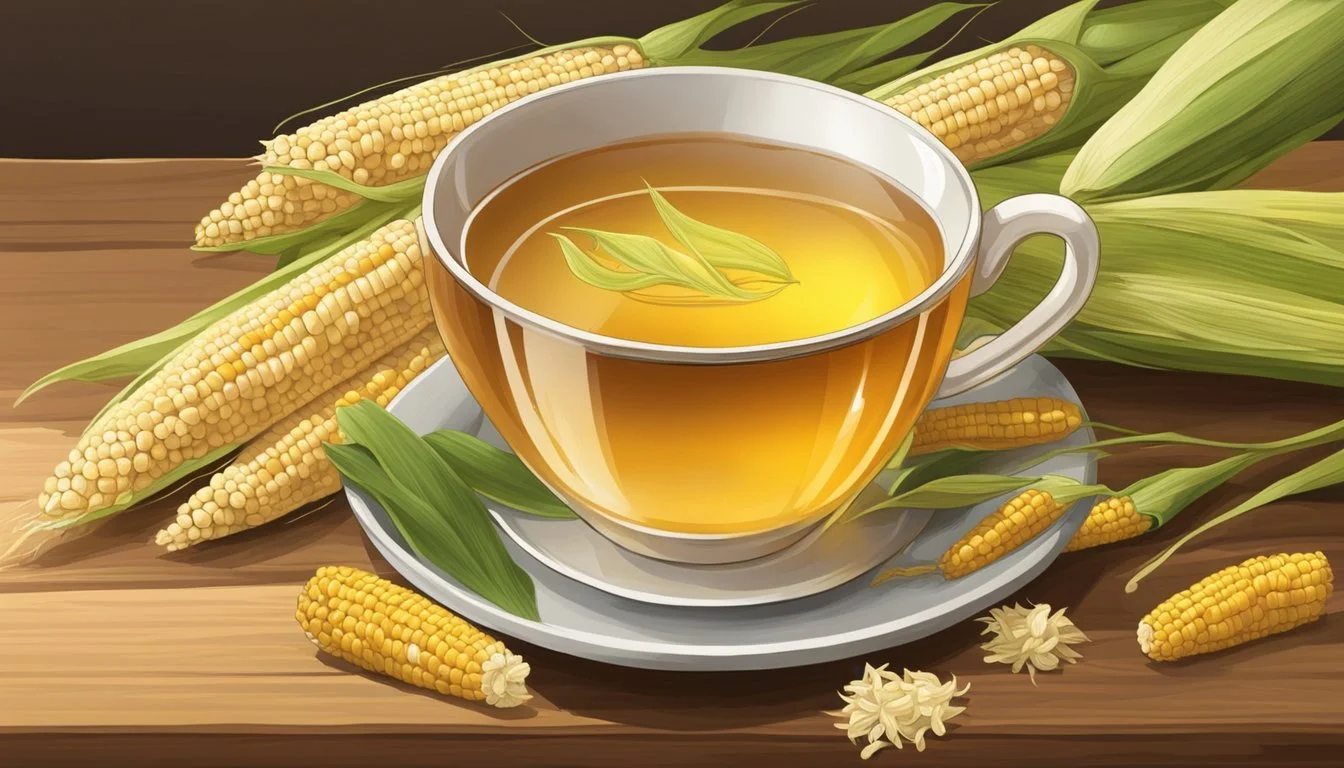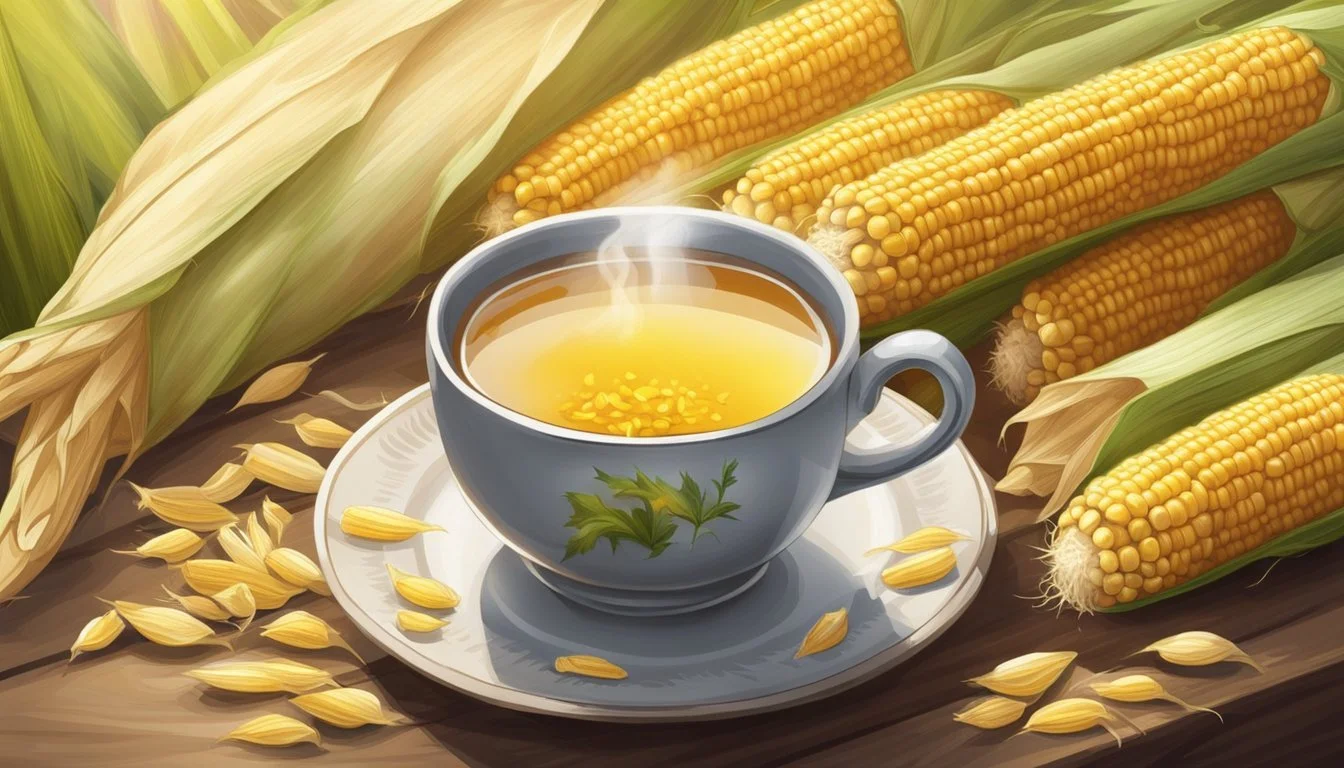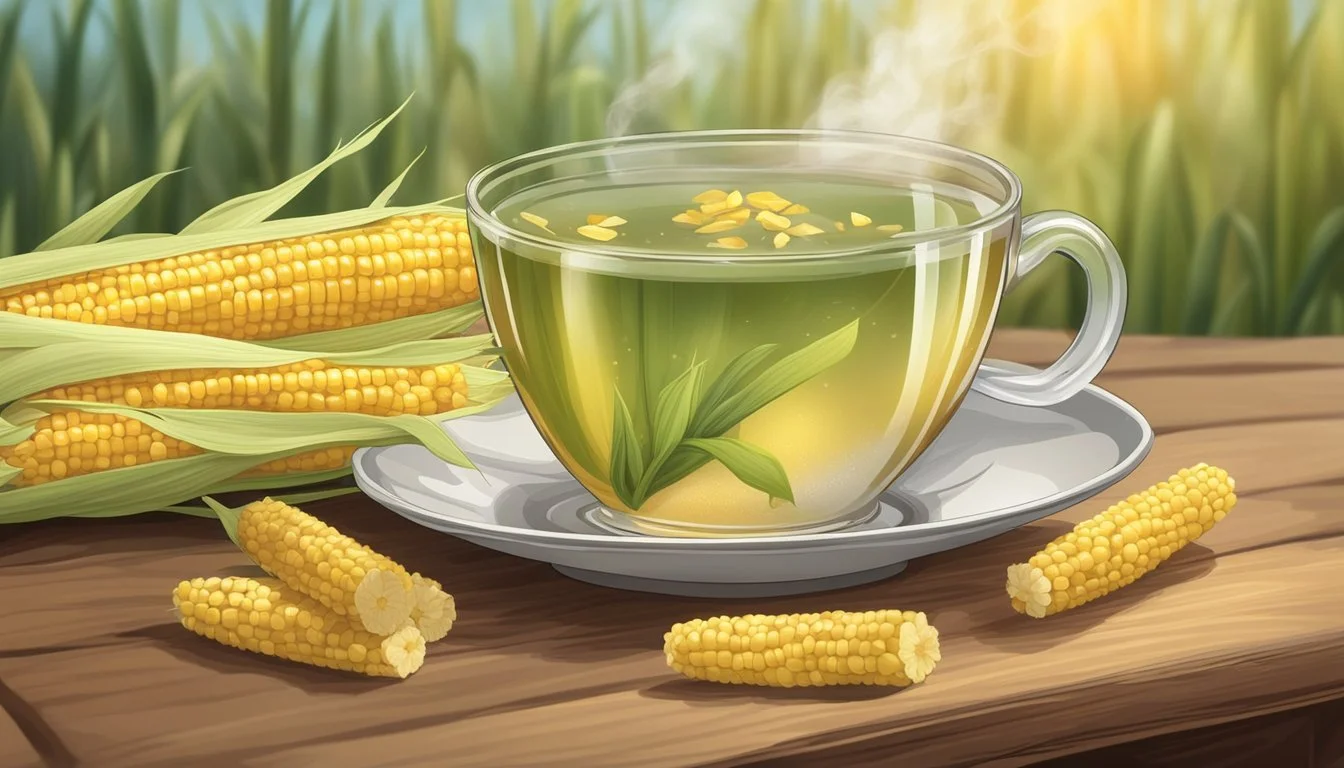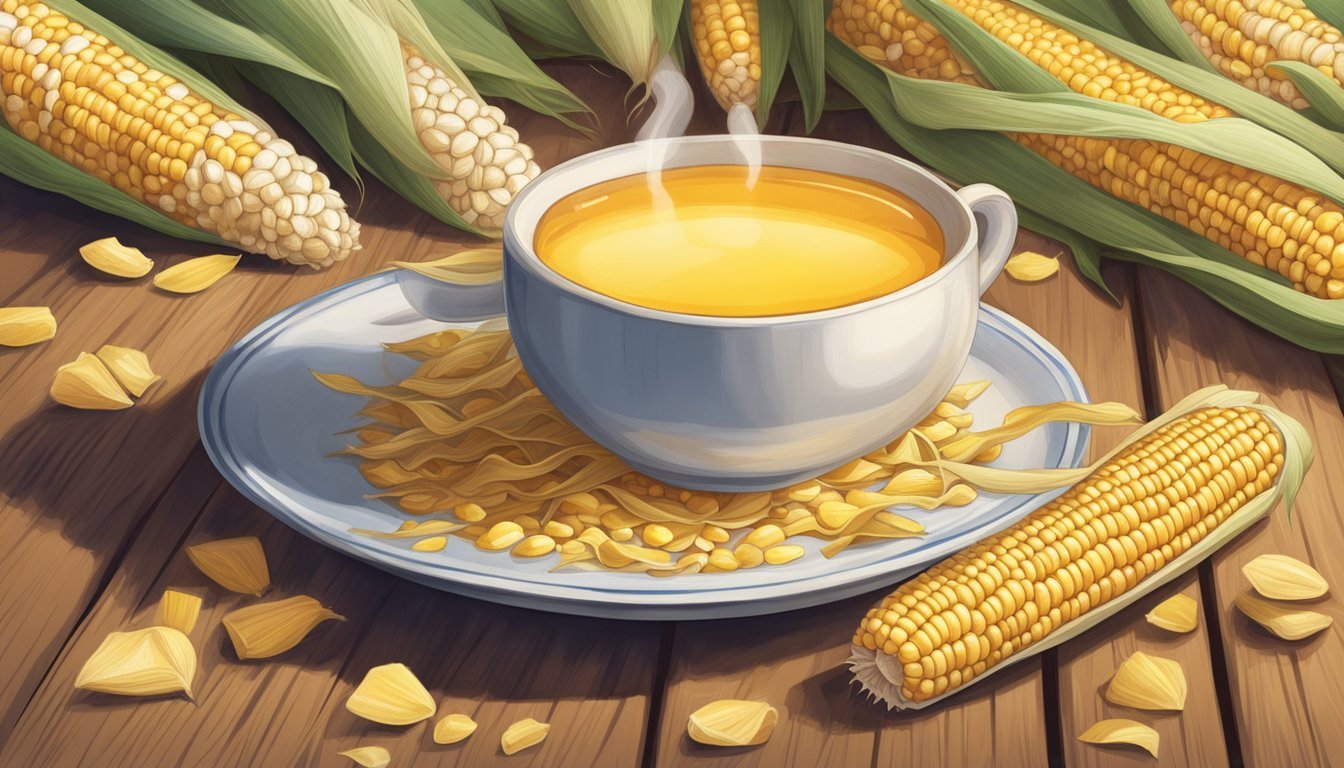Corn Silk Tea Benefits
Unveiling Its Diuretic and Soothing Properties
Corn silk tea is a unique herbal beverage made from the silky threads found underneath the green husks of corn. These threads, known as corn silk, have long been used in traditional medicine for their potential health benefits. As an herbal tea, corn silk is caffeine-free and is consumed for its soothing properties as well as its potential medicinal uses.
Recognized for its mild, slightly sweet flavor, corn silk tea is appreciated not only for its taste but also for its role as a natural diuretic. This property can help promote the removal of excess fluids from the body and may assist in conditions related to water retention. Additionally, its diuretic effect is often sought by those dealing with kidney conditions who require increased urine flow without the harsh impacts of pharmaceutical diuretics.
While it's clear that corn silk tea is not a rich source of nutrients, the interest in its consumption lies in its potential to support various health concerns. The tea is sometimes considered by individuals seeking natural support for urinary tract health, and it is frequently used as an adjunct to manage mild ailments such as bloating or high blood pressure. More research may be needed to fully understand the extent of its medicinal capabilities, but the existing anecdotal evidence places corn silk tea on the map of therapeutic herbal teas.
Origin and History
Corn silk, the silky tassels inside the husks of corn (Zea mays), has been used for centuries, steeped in a tradition that showcases its significance in various cultures, particularly among Native Americans and within traditional medicine systems like those of China.
Cultural Significance
Corn silk was originally used by Native Americans who first cultivated maize, the plant we now commonly refer to as corn. In the warm climates of Mexico and the American continent, it was not just a crop for sustenance but also held ritual and medicinal importance. Corn silk, specifically, was valued for its healing properties and was oftentimes a component of Native American medicine.
Corn Silk's Historical Use
In the annals of traditional medicine, corn silk was employed as a natural remedy for a variety of ailments. Its uses extended into traditional Chinese medicine, where it was recorded for its benefits in addressing conditions related to the urinary tract. The history of corn silk reveals a timeline that intersects with the practices of healers and herbalists who recognized its diuretic properties early on.
Corn Silk: The Plant Itself
Corn silk is a natural byproduct of the corn plant, known scientifically as Zea mays, and is identified by its long, silky threads that extend from the ear of the corn within its husk. As an overlooked part of the plant, corn silk has found its way into traditional remedies and herbal teas.
Botanical Profile
Zea mays, the Latin name for corn, classifies the plant within the Poaceae family. Corn silk refers to the stigmas - the long, thread-like strands - of the female flowers of the plant. They emerge from the top of the corn's ear, protected by leaves and the husk. Individually, the strands are fine and lightweight with a slight sheen, contributing to their silk-like texture. These stigmas play a crucial role in the plant's reproduction, catching pollen grains that fertilize the kernels.
Appearance of Corn Silk:
Strands: Thin, elongated, silky
Color: Typically yellow to brownish-green when fresh
Location: Top of the corn ear, inside the husk
Harvesting Corn Silk
Corn silk can be harvested when the corn reaches the silk stage, which is shortly before the plant fully matures and is ready for corn ear collection. It's essential to gather corn silk during dry weather and to handle the delicate strands gently to preserve their integrity.
Harvesting Steps:
Peel back the husk of the corn.
Carefully remove the visible silk from the top of the ear.
Ensure to leave the husk and the leaves intact to protect the developing corn kernels.
After harvesting, the corn silk can be washed and then dried for storage or immediate use. It's important to note that only the silk from non-GMO and pesticide-free corn should be used for consumption to avoid potential chemical exposure.
Nutritional and Medicinal Properties
Corn Silk Tea, while not abundant in vitamins and minerals, is regarded for its medicinal properties derived from its active compounds.
Vitamins and Minerals Content
Corn Silk Tea contains negligible amounts of vitamins and minerals; its nutritional profile does not notably contribute to daily recommended intakes. Specifically, analysis has shown it does not have measurable levels of potassium, calcium, vitamin C, vitamin K, or magnesium.
Active Compounds and Antioxidants
The medicinal benefits of Corn Silk Tea are mainly attributed to its active compounds and antioxidants. It contains various flavonoids, which are a group of polyphenolic molecules with antioxidant properties. These compounds are believed to help reduce inflammation and oxidative stress. Additionally, the tea's diuretic properties may stem from these bioactive ingredients. Corn silk also contains amino acids and polysaccharides, which might contribute to its health effects.
Health Benefits
Corn silk tea is recognized for its potential role in supporting urinary tract health, regulating blood sugar levels, aiding kidney function, and providing anti-inflammatory benefits for the skin.
Diuretic Effects and the Urinary Tract
Corn silk tea acts as a natural diuretic, promoting an increase in urine flow. This can be particularly beneficial in preventing urinary tract infections (UTIs) and reducing the likelihood of kidney stone formation. By aiding in the flushing out of toxins from the urinary system, it supports overall urinary tract health.
Blood Sugar Regulation
Regular consumption of corn silk tea may have positive effects on blood sugar regulation, making it a beverage of interest for managing diabetes. Its potential to stabilize blood sugar stems from its influence on insulin levels and sensitivity.
Supporting Kidney Function
The diuretic property of corn silk tea benefits the kidneys by reducing fluid retention and potentially preventing the formation of kidney stones. It fosters the removal of waste, which can help maintain kidney health and may ease the burden on the liver.
Anti-inflammatory and Skin Health
Corn silk tea contains compounds with anti-inflammatory properties, which can be instrumental in offering relief for conditions such as gout and arthritis. The soothing effect it has on inflammation can also extend to skin health, helping to improve complexion and address certain skin issues.
How to Make Corn Silk Tea
To ensure a soothing cup of Corn Silk Tea, one must carefully prepare the corn silk—either fresh or dried—and follow proper brewing methods for the best quality tea.
Preparing Fresh Corn Silk
To prepare fresh corn silk, gently remove the silky strands from the top of an ear of corn. One ear of corn will typically provide enough silk for two to three cups of tea. Fresh corn silk should be thoroughly washed to remove any dirt or debris before use. It is advisable to keep the strands long, as they will be easier to strain out after steeping.
Using Dried Corn Silk
For using dried corn silk, select a high-quality source that has been carefully dried and stored. The process is more straightforward; measure approximately two tablespoons of dried corn silk per cup. Dried corn silk can be stored in a cool, dry place and used as needed, which is convenient and enables year-round access for tea making.
Brewing Methods and Tips
There are several methods for brewing the tea:
Steeping: For a mild, sweet flavor, one can add water and corn silk to a pot, bring it to a boil, and then simmer with the lid on for about 10 minutes. Afterward, let it steep off the heat for an additional 30 minutes.
Direct method: Alternatively, place corn silk in a mug or jar and pour hot water directly over it. Let it steep for 5 to 10 minutes for a stronger decoction.
Regardless of the method, after steeping, strain the corn silk from the tea. One can sweeten the beverage with honey if desired, but this tea also works well as a simple cup. Enjoy it hot or cool it down for a refreshing iced tea. Brewing tips for a solid cup include maintaining a low simmer to avoid bitterness and timing the steep precisely to balance flavor extraction.
Potential Side Effects and Considerations
While corn silk tea is generally considered safe for most, it can have potential side effects and interact with medications. Individuals should be aware of these considerations, especially when pregnant, breastfeeding, or suffering from allergies.
Interactions with Medications
Corn silk tea has diuretic properties, meaning it can enhance urine production. This effect can interact with diuretic medications, potentially amplifying their action and leading to dehydration or an imbalance in electrolytes. It may also interfere with blood pressure medications and antidiabetic drugs. Individuals taking any prescription medications should consult with a healthcare provider before consuming corn silk tea.
Pregnancy and Breastfeeding
Due to a lack of in-depth research, the safety of corn silk tea during pregnancy and breastfeeding is not well-established. Pregnant women should err on the side of caution and avoid the tea, as the diuretic effect can alter fluid and electrolyte balance. For those breastfeeding, it is similarly recommended to consult a healthcare provider before consumption to avoid potential risks to the infant.
Allergic Reactions and Sensitivities
Corn silk tea may trigger allergic reactions in individuals with sensitivities to corn or pollen-related allergies. Signs of an allergic reaction can include itching, hives, or swelling. Those who have a known allergy to corn or other plants in the Poaceae family, which includes grasses, should avoid corn silk tea. If someone with a bee sting allergy experiences a reaction to corn silk tea, they should discontinue use and consult a healthcare provider as it could indicate a more severe pollen allergy.
Culinary Uses and Variations
Corn silk tea serves both as a healthful beverage and a versatile culinary ingredient. Its gentle sweetness can enhance a variety of dishes, offering a unique culinary experience.
Corn Silk as a Culinary Ingredient
Corn silk's subtly sweet taste makes it a distinctive ingredient in the kitchen. Young and tender corn silk can be used as:
Topper: As an unconventional yet delightful garnish, corn silk can be sprinkled over salads, tacos, and soups.
Infusion: Incorporating corn silk in vinegar infusions imparts a mild sweetness, creating nuances in homemade dressings and marinades.
Creating Blended Herbal Teas
Corn silk tea stands out when blended with other herbal teas. Consider the following to enrich the flavor profile:
Sweetness: To enhance the natural sweetness of corn silk, adding honey creates a soothing and comforting drink suitable for all ages.
Herbal Infusion: A blend of corn silk and other herbs, such as peppermint or chamomile, can result in a multi-dimensional herbal tea with various health benefits.
By experimenting with corn silk, both as a stand-alone ingredient and part of a blended herbal concoction, culinary enthusiasts can discover new taste dimensions and benefits.
Exploring the Lore and Folk Medicine
In the realm of folk medicine, corn silk tea has been ascribed properties ranging from anti-inflammatory benefits to being an effective diuretic. These traditional applications underline the significance of corn silk in herbal healing practices.
Myths and Stories
In various cultures, corn silk has been entrenched in folklore, often attributed with weather prediction abilities. The color of the silk was believed to foretell the forthcoming weather, with red silk signaling sunny days and white indicating rain. While scientific support for these claims is lacking, these stories underscore the intertwined relationship between agriculture, weather, and traditional wisdom.
Modern Herbalist Perspectives
Today's herbalists view corn silk tea through a lens of contemporary understanding while respecting its historical use in traditional medicine. They recognize it as a mild diuretic that may aid in reducing symptoms of gout and arthritis due to its potential anti-inflammatory properties. Herbalists might suggest corn silk tea to support the body's elimination of excess fluid or to soothe inflammation. Corn silk's influence on bile production, a fluid that aids in digestion, further solidifies its place in herbal remedy strategies for optimizing digestive health. However, they are also careful to use evidence-based approaches, acknowledging its historical context but focusing on current research to support health claims.
Comparative Analysis
Before delving into the specifics, it's important to note that corn silk tea is a beverage with historical roots in medicinal practices, recognized primarily for its diuretic properties and potential health benefits, particularly regarding blood pressure and urinary tract issues.
Corn Silk Tea vs Other Diuretics
Corn Silk Tea:
Property: Natural diuretic
Health Benefit: May aid in lowering blood pressure, alleviating water retention
Other Diuretics:
Property: Pharmaceutical (e.g., Furosemide)
Health Benefit: Strong diuretic effect, prescribed for fluid build-up, heart failure
Comparatively, corn silk tea is purported to be a gentler diuretic option than pharmaceutical diuretics. Its historical use by Chinese and Native American cultures suggests a therapeutic potential in managing conditions related to fluid retention and blood pressure. While prescription diuretics are formulated to elicit a significant diuretic effect, corn silk tea may offer a more subtle approach, potentially with fewer side effects.
Efficacy in Treating Specific Conditions
Conditions like hypertension and urinary tract irritation benefit from the diuretic nature of treatments. Corn silk tea's diuretic effect can lead to increased urine production, which may help in lowering blood pressure and cleansing the urinary tract.
Hypertension: Reduces blood volume through increased urination, potentially lowering blood pressure
Urinary Tract: Flushes out the urinary system, reducing the risk of infections and kidney stones
Clinical evidence supporting the efficacy of corn silk tea is less robust than that for conventional diuretics. However, there is a body of research and anecdotal support for its use in mild conditions related to the urinary system and blood pressure management.
Nutrition Information and Research
In assessing the value of Corn Silk Tea, it is critical to consider both its nutrient content and the research supporting its health claims. This section provides a detailed look at the nutrition information derived from corn silk and a summary of scientific studies that examine its potential health benefits.
Scientific Studies on Corn Silk Tea
Research has explored Corn Silk Tea's pharmacological properties, particularly its potential roles in addressing conditions such as hypertension, inflammation, and blood sugar regulation. A systematic review and meta-analysis have noted the antihypertensive effect of Corn Silk Tea, highlighting its use in traditional medicine to improve clinical outcomes in patients with hypertension. Further studies have investigated its use as a diuretic which may offer therapeutic benefits for kidney disorders and contribute to its utility in managing heart disease. While these findings are promising, more comprehensive and large-scale clinical trials are needed to substantiate these effects.
Nutritional Breakdown and Calories
Calories and Nutrient Content:
Corn Silk Tea is traditionally esteemed for its medicinal properties rather than its nutritional contribution. Accordingly, the beverage is:
Calories: 0
Protein: 0 grams
Fat: 0 grams
Carbohydrates: 0 grams
This makes Corn Silk Tea a calorie-free option, favoring those who are monitoring their calorie intake or managing obesity. Additionally, the tea is caffeine-free, which can be an important consideration for individuals looking to reduce caffeine consumption or those sensitive to its effects.
Blood Sugar Levels:
Preliminary studies suggest that Corn Silk Tea may have a stabilizing effect on blood sugar levels, which could be beneficial for individuals with diabetes or those at risk. However, these effects need to be confirmed by rigorous scientific studies.







